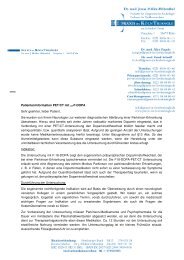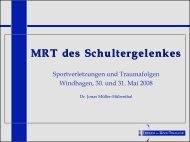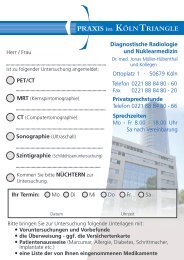16.06.2010 Akkurates Staging beim Bronchial-Karzinom als
16.06.2010 Akkurates Staging beim Bronchial-Karzinom als
16.06.2010 Akkurates Staging beim Bronchial-Karzinom als
Erfolgreiche ePaper selbst erstellen
Machen Sie aus Ihren PDF Publikationen ein blätterbares Flipbook mit unserer einzigartigen Google optimierten e-Paper Software.
<strong>Akkurates</strong> <strong>Staging</strong> <strong>beim</strong> <strong>Bronchial</strong>-<strong>Karzinom</strong> <strong>als</strong><br />
Grundlage für eine optimale Therapie<br />
FDG-PET/CT<br />
Dr. Jonas Müller-Hübenthal<br />
Praxis im KölnTriangle<br />
Ottoplatz 1<br />
50679 Köln<br />
Mittwoch, 16. Juni 2010<br />
PET/CT <strong>Bronchial</strong>Ca
Entwicklung der PET/CT<br />
1933 Entdeckung der Positronenstrahlung (Thibaut)<br />
1953 erste Bildgebung eines Hirntumors mit den<br />
Positronenstrahler As-24 (Gordon L. Brownell)<br />
1974 erstes CT in Köln (Helmut Müller-Hübenthal)<br />
1975 Einführung der PET (Michael M. Ter-Pergossian)<br />
1977 PET-Messung des Glucosestoffwechsels im Hirn<br />
(Sokoloff)<br />
1990 Ganzkörper-PET (Michael Phelps)<br />
1994 neue Detektoren für PET: LSE, YSE (Thomas F. Budinger)<br />
1995-2000 Entwicklung Prototyp PET/CT (David Townsend)<br />
2001 erstes PET/CT in Deutschland (Essen)<br />
2006 erstes PET/CT in Köln<br />
Quelle: Schicha/Schober: Nuklearmedizin, Valk: PET und Wikipedia<br />
Mittwoch, 16. Juni 2010<br />
PET/CT <strong>Bronchial</strong>Ca
Warum ist PET/CT besser <strong>als</strong> PET + CT?<br />
Bessere Schwächungskorrektur<br />
Bessere Detailerkennbarkeit<br />
Schnellere Untersuchung mit<br />
höherer Auflösung<br />
Anatomische Landkarte<br />
Weniger intermediäre Befunde<br />
1+1=3!<br />
Mittwoch, 16. Juni 2010<br />
PET/CT <strong>Bronchial</strong>Ca
Mit welchen Substanzen arbeiten wir?<br />
F18-FDG - Zuckerstoffwechsel<br />
F18-Cholin -<br />
Membranstoffwechsel<br />
F18-Tyrosin -<br />
Eiweißstoffwechsel<br />
F18-Dopamin - Botenstoff<br />
F18-Fluorid -<br />
Knochenstoffwechsel<br />
Ga68-DOTATOC -<br />
Somatostatinrezeptoren<br />
Mittwoch, 16. Juni 2010<br />
PET/CT <strong>Bronchial</strong>Ca
PET/CT Diagnosen der Praxis im KölnTriangle<br />
n=950<br />
06/2008-06/2010<br />
Mittwoch, 16. Juni 2010<br />
PET/CT <strong>Bronchial</strong>Ca
Untersuchungsablauf FDG-PET/CT<br />
Morgens nüchtern<br />
Blutzuckermessung<br />
FDG-Injektion i.v.<br />
45-60 min Ruhephase<br />
Standard-Ganzkörperaufnahmen<br />
Ggf. Zusatzaufnahmen Kopf<br />
Pause (Frühstück im Café gegenüber)<br />
Spätaufnahmen (dual time point<br />
imaging)<br />
Ggf. mit KM-CT und<br />
Spezialmaßnahmen<br />
Vorläufige Befundbesprechung<br />
Mittwoch, 16. Juni 2010<br />
PET/CT <strong>Bronchial</strong>Ca
Dual time point imaging<br />
1 und 2,5-3h post<br />
injektionem<br />
FDG Akkumulation bei<br />
malignen und wash-out<br />
bei benignen Prozessen<br />
10% SUVmax Anstieg<br />
Sens. 100%, Spez. 89%<br />
besonders für<br />
intermediäre Läsionen<br />
mit SUV max um 2,5<br />
Erhöht Detektion bei<br />
Leber, Wirbelsäule, NN<br />
Deumra et al. JNM 2003<br />
Gupta et al. Chest 1998<br />
Mathies et al JNM 2002<br />
Mittwoch, 16. Juni 2010<br />
PET/CT <strong>Bronchial</strong>Ca
PET/CT-Untersuchungstechnik<br />
n=997<br />
Mittwoch, 16. Juni 2010<br />
PET/CT <strong>Bronchial</strong>Ca
Strahlenbelastung<br />
Ca. 7 mSv für PET<br />
Ca. 3-4 mSv für LD-CT<br />
Ca. 20 mSv für CT Kopf,<br />
Thorax und Abdomen<br />
Jährliche natürliche<br />
Strahlenbelastung 2,4 mSv<br />
Theoretischer Verlust an<br />
Lebenserwartung im Bereich<br />
von Tagen<br />
<strong>Bronchial</strong>-Ca.: Verlust an<br />
Lebenserwartung 12-13 Jahre!<br />
Strahlenschutzkommision 2006<br />
Mittwoch, 16. Juni 2010<br />
PET/CT <strong>Bronchial</strong>Ca
PET/CT Untersuchungstechnik<br />
Dynamische Aufnahmen CT n=997<br />
Mittwoch, 16. Juni 2010<br />
PET/CT <strong>Bronchial</strong>Ca
Klinischer Teil: SPN, NSCLC und SCLC<br />
Mittwoch, 16. Juni 2010<br />
PET/CT <strong>Bronchial</strong>Ca
SPN solitary pulmonary nodule<br />
Solitärer Rundherd auch bei bek.<br />
Malignom in 50% benigne<br />
PET Sensitivität 97% Spezifität<br />
78% bei SUVmax>2,5 bzw. ><br />
mediast. Blutpoolniveau<br />
pretest Wahrscheinlichkeit<br />
zwischen 12 und 69% - sonst<br />
direkt OP oder Verlauf<br />
Auch bei neg. PET-Befund<br />
Verlaufskontrolle erforderlich<br />
F<strong>als</strong>ch pos: Sarkoidose,<br />
Aspergillose, Tbc, chron.<br />
Pneumonie, Fremdkörperreaktion,<br />
Abszeß<br />
F<strong>als</strong>ch neg: broncho-alveoläres<br />
Carcinom, Karzinoid<br />
Mittwoch, 16. Juni 2010<br />
PET/CT <strong>Bronchial</strong>Ca
NSCLC <strong>Staging</strong><br />
PET/CT ist Standard<br />
IA Indikation Onko-PET III<br />
ACCP Leitlinie 2007<br />
Neue S3 Leitlinie<br />
wird von zertifizierten<br />
Lungenkrebszentren gefordert<br />
Ändert gegenüber konv. <strong>Staging</strong><br />
(Rö, CT, Szinti) in über 19-41%<br />
der Fälle den therapeutischen<br />
Ansatz<br />
Reduktion nichtkurative OP um<br />
50%<br />
SUVmax unabh. Prognosefaktor<br />
Van Tinteren, PLUS, Lancet 2002<br />
Fischer N Engl J Med 2009<br />
Mittwoch, 16. Juni 2010<br />
PET/CT <strong>Bronchial</strong>Ca
NSCLC T-<strong>Staging</strong><br />
T3 und T4: Infiltration von<br />
Pleura<br />
Mediastinum<br />
Thoraxwand<br />
Gefäße<br />
Vorwiegend CT-Kriterien<br />
signifikante Verbesserung des T-<br />
<strong>Staging</strong> ggü. Einzelmodalität<br />
Verbesserung der Befundsicherheit<br />
durch PET: Pleuracarcinose<br />
Reske et al Eur J Nucl Med 2000<br />
Pauls, Reske et al. Nuklearmedizin 2007<br />
Antoch Radiology 2003<br />
Mittwoch, 16. Juni 2010<br />
PET/CT <strong>Bronchial</strong>Ca
NSCLC N-<strong>Staging</strong><br />
PET/CT insgesamt Sensitivität 88% und<br />
Spezifität 92*%<br />
LK 6-10 mm 83%<br />
LK
NSCLC M-<strong>Staging</strong><br />
Wesentliche Leistung der PET/CT <strong>als</strong><br />
Ganzkörperuntersuchung<br />
Hirn* Sens. 60%, bei Läsionen < 1 cm 40%<br />
NN **: Detektion Sens. 100% Spez 80%<br />
Knochen(mark)***: Sens. 92%, Spez. 99%<br />
Leber****: PET/CT Sens. 66% Accur. 83%<br />
Hintergrund: im Einzelfall<br />
Metastasenchirurgie solitärer Hirn- oder<br />
NN-Meta möglich (+Rx und adj. Chemo)<br />
Ca. 10-15% der Fälle bislang unbekannte<br />
Metastasenlokalisation<br />
*Rohren et al. Radiology 2003<br />
** Yun et al JNM 2001<br />
***Bury et al. EUR J Nucl Med 1998<br />
**** Rappeport et al, Acta Radiol. 2007, Abdom Imaging 2007<br />
Mittwoch, 16. Juni 2010<br />
PET/CT <strong>Bronchial</strong>Ca
NSCLC M-<strong>Staging</strong> NN Metastasierung<br />
Diskriminatoren<br />
Adenom vs non-<br />
Adenom:<br />
CT-Nativdichte Leber Sens<br />
93%, Spez. 90%<br />
PET**: physiol. Uptake SUV<br />
max bis 2,5<br />
*Kumar JNM 2004<br />
**Bagheri JNM 2004<br />
Mittwoch, 16. Juni 2010<br />
PET/CT <strong>Bronchial</strong>Ca
NSCLC neoadj. Therapiekonzept<br />
EORTC response Kriterien*<br />
PET/CT unabhängiger<br />
Prädiktor für Overall Survival<br />
(OS) und Progression Free<br />
Survival (PFS)**<br />
PET-neg. Restbefund: bis zu 10 7<br />
maligne Zellen***<br />
A: 4 Zyklen, B: 6 Zyklen, C: 4-6<br />
Zyklen unvollst. Therapie<br />
MTV: metabolisches Volumen<br />
*Young EUR J Cancer 1999<br />
**Ryu et al Lung Cancer 2002<br />
*** Graphik aus: Wahl et al JNM 2009<br />
Mittwoch, 16. Juni 2010<br />
PET/CT <strong>Bronchial</strong>Ca
NSCLC Rezidivdiagnostik<br />
PET ist dem CT bei der<br />
Diagnose des Lokalrezidivs<br />
überlegen<br />
Auch kleine ungewöhnlich<br />
lokalisierte Fernmetastasen<br />
können zuverlässig erkannt<br />
werden.<br />
Erneuter curativer Ansatz<br />
möglich?<br />
Mittwoch, 16. Juni 2010<br />
PET/CT <strong>Bronchial</strong>Ca
SCLC<br />
Zu konv. <strong>Staging</strong> 33%<br />
upstaging von limited zu<br />
extensive disease<br />
Korrekter<br />
Metastasenausschluß und<br />
damit (potentiell) kurative<br />
Therapieoption<br />
Nachweis und Ausschluß von<br />
Knochenmarkbefall - Biopsie<br />
nicht erforderlich<br />
Baum et al Der Onkologe 2008<br />
Mittwoch, 16. Juni 2010<br />
PET/CT <strong>Bronchial</strong>Ca
Kosten und Erstattungssituation<br />
$$$$$$$$$$$<br />
€€€€€€€€€€€<br />
£££££££££££<br />
Mittwoch, 16. Juni 2010<br />
PET/CT <strong>Bronchial</strong>Ca
Erstattungssituation - Was kostet PET/CT?<br />
F18-FDG-PET/CT:<br />
zwischen 1800 und 2500<br />
EUR inkl. Nuklid, KM<br />
und MwSt.<br />
Bei speziellen Tracern<br />
mit Transport aus Berlin<br />
oder Erlangen auch mehr<br />
F18-FDG PET an älterem<br />
Gerät: 700-900 EUR<br />
Bildbeispiel: Pleuramesotheliom li. cervikal mit Carotisummauerung<br />
Mittwoch, 16. Juni 2010<br />
PET/CT <strong>Bronchial</strong>Ca
Vergütung der PET in Europa<br />
B NL F UK I DK FIN CH E D A<br />
Malignom<br />
Lunge + + + + + + + + + - -<br />
Dickdarm + + + + + + + + + - -<br />
Lymphdrüsen + + + + + + + + + - -<br />
Kopf-H<strong>als</strong> + + + + + + + + + - -<br />
Melanom + + + + + + + + + - -<br />
Speiseröhre + + + + + + + - + - -<br />
Bauchspeicheldrüse + + + + + (+) + - - - -<br />
Brust - + + + + (+) (+) + + - -<br />
Schilddrüse - + + + + + (+) + + - -<br />
Hirn + + + + + + + + - - -<br />
Dietlein, Schicha 2003 Nuklearmedizin 42: 80-85<br />
Mittwoch, 16. Juni 2010<br />
PET/CT <strong>Bronchial</strong>Ca
73j., m.<br />
Beispiel Kassenbürokratie<br />
Ext. CT: Pleuraständiger Tumor,<br />
keine Thoraxwandinfiltration.<br />
6 Wochen später<br />
(Bearbeitungszeit des PET/CT<br />
Antrages): knöcherne<br />
Infiltration der zweiten Rippe<br />
OP: aufwändige<br />
Thoraxwandresektion<br />
erforderlich<br />
Mittwoch, 16. Juni 2010<br />
PET/CT <strong>Bronchial</strong>Ca
Perspektiven<br />
Somatostatinrezeptor<br />
-PET/CT<br />
Molekulare<br />
Bildgebung<br />
Strahlentherapieplanung<br />
Mittwoch, 16. Juni 2010<br />
PET/CT <strong>Bronchial</strong>Ca
Ga68-DOTATOC-PET/CT: GlomusTu & Karzinoid<br />
Mittwoch, 16. Juni 2010<br />
PET/CT <strong>Bronchial</strong>Ca
Perspektiven: Molekulare Bildgebung<br />
Mittwoch, 16. Juni 2010<br />
PET/CT <strong>Bronchial</strong>Ca
Perspektiven: PET/CT in der Strahlentherapie<br />
Multi-Leaf-Kollimatoren<br />
Intensitätsmodulierte<br />
Therapie (IMRT)<br />
Radioimmuntherapie<br />
Protonentherapie<br />
Biologische<br />
Zielvolumendefinition<br />
Courtesy Prof. Baum<br />
Mittwoch, 16. Juni 2010<br />
PET/CT <strong>Bronchial</strong>Ca
Zusammenfassung<br />
PET/CT ist Standard <strong>beim</strong><br />
Intitial- und Rezidivstaging<br />
des NSCLC<br />
PET/CT ändert die<br />
Therapiestrategie<br />
grundlegend bei einem<br />
Drittel der Patienten<br />
Intensiv stoffwechselaktive<br />
Tumoren (SUVmax>5-9)<br />
haben eine schlechte<br />
Prognose<br />
Mittwoch, 16. Juni 2010<br />
PET/CT <strong>Bronchial</strong>Ca
Zusammenfassung<br />
PET/CT reduziert <strong>beim</strong> NSCLC die Anzahl<br />
nichtkurativer Thorakotomien.<br />
PET/CT reduziert die Anzahl invasiver<br />
Mediastinoskopien<br />
PET/CT kann Rezidive früher (rechtzeitig?)<br />
erkennen.<br />
PET/CT eignet sich zum<br />
Therapiemonitoring<br />
PET/CT ist teuer und aufwändig, aber<br />
nichtinvasiv.<br />
PET/CT <strong>beim</strong> NSCLC ist kosteneffizient.<br />
PET/CT <strong>beim</strong> NSCLC wird auch von den<br />
gesetzl. Kassen bezahlt.<br />
Mittwoch, 16. Juni 2010<br />
PET/CT <strong>Bronchial</strong>Ca
Vielen Dank für Ihre Aufmerksamkeit!<br />
Das Team der<br />
Praxis im KölnTriangle<br />
Mittwoch, 16. Juni 2010<br />
PET/CT <strong>Bronchial</strong>Ca
Mittwoch, 16. Juni 2010<br />
PET/CT <strong>Bronchial</strong>Ca


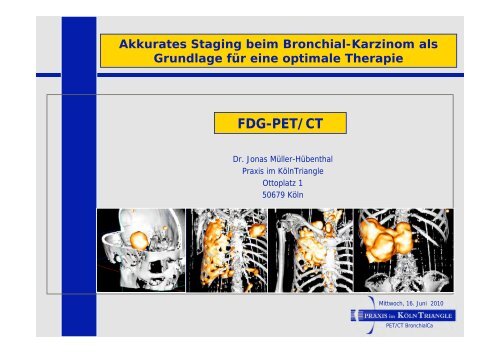
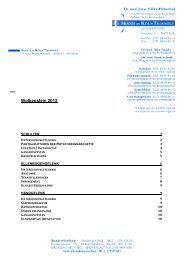
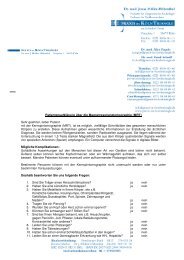
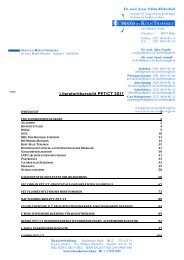
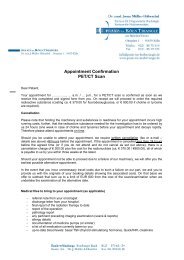

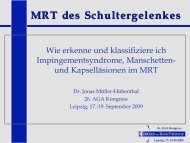
![04.08.09 Fallvorstellung: [Ga68]DOTATOC zur PET-Darstellung](https://img.yumpu.com/11180529/1/190x143/040809-fallvorstellung-ga68dotatoc-zur-pet-darstellung.jpg?quality=85)
